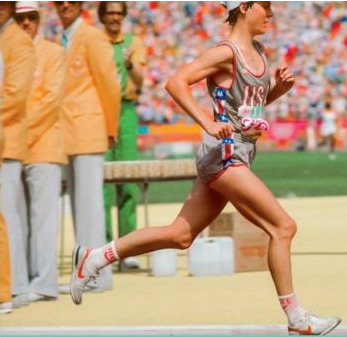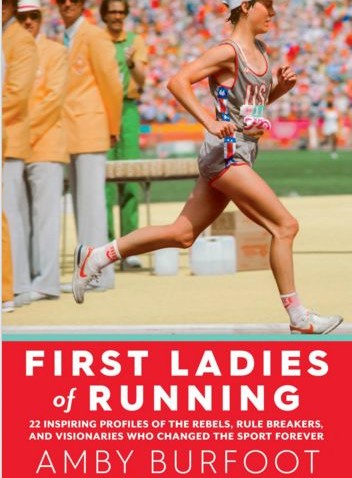Book excerpt: First Ladies of Running


Amby Burfoot is the 1968 winner of the Boston Marathon and a prominent running journalist. In his book First Ladies of Running, he profiles the stories of 22 female athletes from the 1960’s through to the 1990’s. The book is out in April. Read an excerpt below:
Roberta Gibb was born in a hospital elevator, eager to begin her athletic, artistic, and intellectual voyage. “You just couldn’t wait to get out,” her mother often told the young Roberta. “You couldn’t wait to explore everything around you.”
Gibb’s biggest adventure began on Friday, April 15, 1966. That afternoon she bought her first pair of running shoes–boys, size 6, Adidas–in downtown San Diego and crossed the street to board a Boston-bound bus. While she had never entered any track meet or road race of any kind, she planned to run the Boston Marathon on April 19–a Tuesday.
She arrived in Boston at 6 pm Monday evening, 18 hours before the marathon’s start. Ravenous after the long, near-starvation bus trip, she wolfed down a huge meal at her parents’ home in Winchester, just outside Boston. She had extra helpings of roast beef, figuring that the protein would her provide premium fuel for the marathon.
Roberta, widely known as “Bobbi,” was 23. Two months earlier she had written to the Boston Marathon postal address for a race application. In short order, she received a curt denial letter. It said, in effect: You can’t run the Boston Marathon because we are an official AAU event, and women aren’t allowed to run longer than 1.5 miles in an AAU race. Besides, women aren’t physiologically capable of running 26.2 miles. Since Boston’s first running in 1897, no woman had ever attempted the historic Marathon.
RELATED: Top reads for runners
RELATED: Read for runners: Proteinaholic
“I was infuriated by the BAA letter,” Gibb recalls “Why did people think women were incapable of so many things? What did they want me to do–start cooking or take up knitting? It was a Catch-22 situation. If women weren’t allowed to attempt the marathon, how could we prove that we could do it?”
On Marathon morning, fearful that she might be arrested if seen, Gibb hid behind a thick forsythia bush about 50 yards in front of the current Hopkinton start line (and about 150 yards in front of the 1966 start). She was wearing a one-piece black tank-top bathing suit, covered by a pair of her brother’s brown Bermuda shorts and a thick hooded sweatshirt.
When roughly half of the 415 men had passed her, Gibb crept out from her hiding place and began running down the side of the road. Around her she heard happy voices. Everyone was excited to be under way. Then, after about half a mile, eerie silence. Next: “Hey, is that a girl over there?”
“No it can’t be. Girls can’t run the marathon.”
But everyone was looking in her direction now. Gibb worried that she was in trouble. “I didn’t know what the guys would do,” she recalls. “I thought they might try to shove me off the road.” So she turned and smiled her prettiest smile.
Several of the runners clustered around her and asked questions, mainly, “Are you planning to go the whole way.” When she answered, Yes, they were universally supportive. Several said: “I wish my wife would run with me.”
A mile later, Gibb began to overheat in the thick sweatshirt. She wanted to toss it off. But again, she wondered what would happen when spectators and marathon police could readily make out her blonde hair and female figure. She told her new friends about her fears. “Don’t worry,” they replied immediately. “It’s a public road. We’ll take care of you. We won’t let anyone bother you.”
Soon journalists on the Marathon press truck spotted Gibb. They sent reports to radio stations who immediately broadcast the bizarre news: A woman was running the Marathon. The radio updates brought cascades of spectators to the courseside, especially at Wellesley College. “I began to hear the noise in Wellesley a half-mile away,” Gibb says. “By the time I got there, it was just overwhelming. I’ve always been sensitive to loud noises. I didn’t like it.”
She ran many of the middle miles with Alton Chamberlin, a Boston veteran. Gibb knew nothing about pace, but he told her they were hitting seven-minute miles. She felt completely comfortable, running well within herself. The Newton hills and Heartbreak were no problem.
Then, at 23 miles, the inevitable crash. Gibb had done all her training on soft surfaces–beach and trails–in cushioned nurses shoes. Now the hard roads and thin-soled running shoes made her feet feel on fire. She developed blisters and tried to change her stride. That only made things worse. “I was going so slow, I felt like a complete failure,” she recalls. “This was my worst run ever, and it happened in the Boston Marathon. I was so disappointed.”
She struggled onward nonetheless, figuring there would be no one left at the finish. Instead, when she got there in 3:21:25, she was greeted by huge crowds and a gaggle of newspaper photographers. Someone led her to a small interview room where the press peppered her with questions. What was she trying to prove? Did she have an axe to grind with men? “They had it all wrong,” Gibb says. “I love men. I simply wanted to disprove false beliefs about women’s limitations. I said I thought women could be feminine and strong and athletic at the same time.”
After the interview, Gibb followed some of the male finishers to the traditional post-marathon beef stew in a Prudential Center cafeteria. She was barred from entering. “Women aren’t allowed,” the security guards told her.
When she arrived home a short time later, she was stunned to find more photographers at her parents’ home. Now they wanted her to tidy up a bit, and display her female skills in the kitchen. “It was stupid,” she says. “I’ve never done much cooking. The only thing I know how to make is fudge.” Nevertheless, ever a people-pleaser, she changed into a polka-dot dress and headed for the kitchen. The domestic photos received as much play in the next day’s papers as her marathon-running photos.
One Wednesday morning headline declared: “Hub Bride First Girl To Run Marathon.” Another: “Marathon’s Course Just A Bridal Path.” Both referred to her marriage three months earlier to old college friend and Navy officer Will Bingay. One story began: “A blonde 23-year old beauty …”
The Boston Marathon immediately released a press statement: “Mrs. Bingay did not run in yesterday’s marathon. There is no such thing as a marathon for a woman.” However, Alton Chamberlin affirmed that she had covered the full distance, adding: “She didn’t look half as bad as some of the men.”
Gibb returned to “win” the next two Boston Marathons, including the 1967 race made famous by Jock Semple’s attack on Kathrine Switzer. Women were not recognized as legit Boston runners until 1972.
That year, Nina Kuscsik became the first official women’s winner. In 1996, on the occasion of the 100th Boston Marathon, the BAA finally awarded a winner’s medal to Gibb, as well as to Sara Mae Berman, winner from 1969 through 1971.
With little left to prove on the roads after 1968, Gibb turned her attention to academics and art. She has had a lifelong and continuing interest in neuroscience, especially Lou Gehrig’s disease (ALS), which claimed a close friend a decade ago. She also sculpts and paints. In 1984, her sculpture was awarded to the first three finishers in the first U.S. Olympic Marathon Trials for women, famously won by Joan Benoit.
Some of her paintings–colorful swirling abstracts–will be made public for the first time this spring.
Gibb, now 73, has continued running through the years, though she never enters races. “I feel so good when I run,” she says. “It makes me so happy. If only everyone else could feel as good in their life as I feel when I’m running, it would probably solve most of the world’s problems.”
A year ago, she thought about attempting to run the 2016 Boston. Now that seems unlikely. She may opt to enter the BAA 5K. “I don’t want to do anything stupid,” she notes. “I’ve got nothing to prove. I did my part fifty years ago. I was the seed. These days I’m so happy that there are millions of women running, continuing to show what we can achieve.”
Adapted with permission from First Ladies of Running, copyright Amby Burfoot, published by Rodale Inc, 2016.


